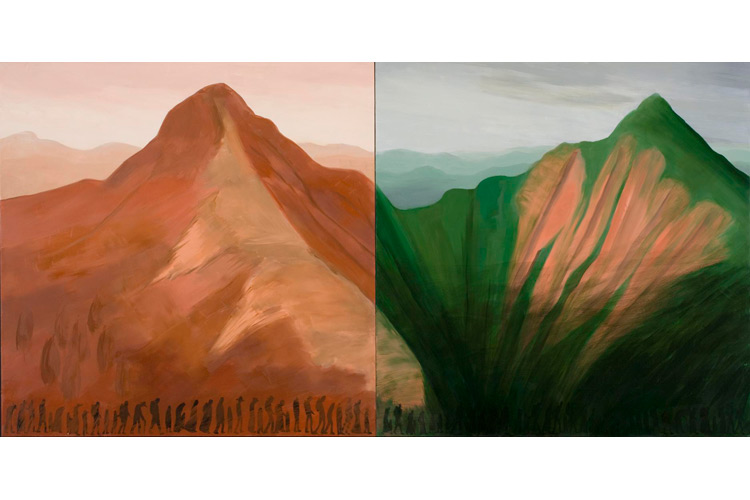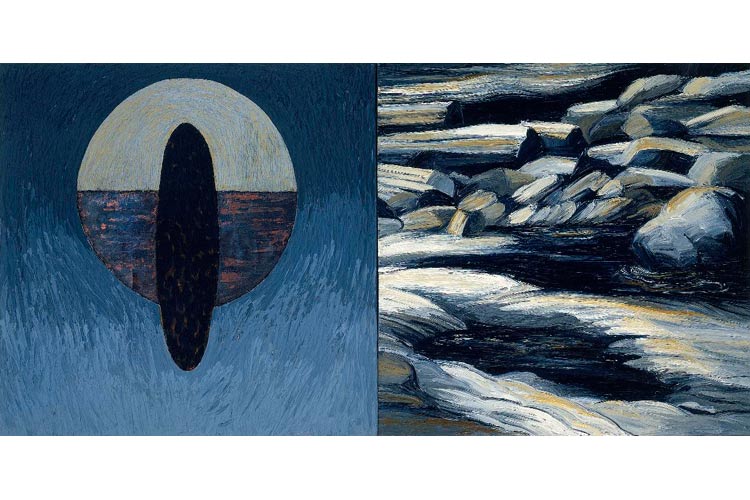Kay WalkingStick rewrites the narrative of Native peoples through her artwork
The community is invited to welcome Kay WalkingStick when her artwork comes to the Kalamazoo Institute of Arts.
Kay WalkingStick has painted from many viewpoints over 50 of her 82 years: As an easterner who fell in love with the landscapes of the west, as a person of Cherokee and European heritage, as a feminist, and as someone who simply enjoys the beauty of the natural world.
The Kalamazoo Institute of Arts will fill all of its main-floor galleries with her work — approximately 65 pieces going back to 1970 — to be shown June 17-Sept. 10. “Kay WalkingStick: An American Artist” is organized by the American Federation of Arts and the Smithsonian’s National Museum of the American Indian.
What goes through her mind when looking at her decades of work? “It’s kind of stunning, I have to tell you,” WalkingStick says from her home in Easton, Pa. “First of all, I didn’t think I’d live this long. Nobody believes that they could possibly get to 82. It’s stunning to think that I’ve been working that long, and I’m still working in the studio. I’ve got things to do this afternoon.”
WalkingStick was planning to get out the saw and hammer after the interview. “I work on wood panels, and they have to be prepared,” she says. “It’s really important to be physically working.”
“I try to make these paintings so that they’ll hold up for, well, a couple hundred years. I worry more about the planet than the paintings, to tell you the truth.”
In her career she’s used acrylics to paint bold, minimalist nudes; then used as many as 30 coats of paint and wax, gouging with woodcutting tools to create abstracts, and used oil on wood to mix the rugged landscapes of the West with Native American images. She’s mixed landscapes and abstractions in diptychs, two-paneled paintings implying dialog or duality. In the ’90s she traveled to Italy, which inspired her use of gold and palladium leaf in her landscapes. Lately. she’s turned to oceanscapes, inspired by the shores of the Newport, Rhode Island area.
“The paintings themselves evoke a mood, an emotion, a response to a place, or an idea, or a concept, so that it is not just a picture of a place or a concept or a thing, but I would hope a somewhat more complex level of response. Many of them, the texture of the thing itself, the texture of the painting, is a part of the whole experience (for the viewer). Especially the earlier ones.” They’re thick, layered, “you can see through the layers into other things.” Some are impressively large, others the size of a book, to be studied. One can’t just look up a digital image of her paintings on the web, she says. “They do have to be experienced.”
Does she ever look at her early work, and think, who is the person who did this? She laughs. “Sometimes I do!”
“I can look at the paintings and be back in that girl’s head, I really can,” she says. “I’ve changed tremendously in many ways. I think I’m more responsible and more open. More able to express myself to people.”
WalkingStick was a newly-married BFA graduate of Beaver College, Glenside, Pa., 1959, when she began her career in earnest. In the ’60s, it was “a different era,” she says, when the culture tamped down outspokenness.
But times changed. The coming feminist and Native American movements had a lasting impact on her work starting in the 1970s.
Discovering heritage, discovering the West
She was born in Syracuse, NY, 1935. Her mother had just left her Cherokee father in Oklahoma. WalkingStick did not know her father, “not at all.” She met him once when she was around nine when he came to stay with the family for a brief time, “got into trouble and left. He was a severe alcoholic,” she says.
Her mother did make sure she was proud of her Native heritage, but WalkingStick grew up in a world not of the Cherokee Nation.
She wasn’t interested in painting landscapes until she visited the West.
“I like a rugged landscape. The landscape here (eastern Pennsylvania) is very beautiful, but I don’t have any real desire to paint rolling hills and fluffy trees, to tell you the truth,” she says.
“I like rugged landscape, and when I first saw it, I was already in my 40s. I came out to Durango, Colorado to teach at Fort Lewis College for a semester. It was kind of a stunning experience, a sea change as they say. One of those experiences where you say, Oh, J—-, how could I have missed it?”
She and her husband drove around the Southwest, saw sights like the Grand Canyon in the snow. “That was just mind blowing, and I didn’t look back.”
WalkingStick had been painting “these big, sort of reductive abstractions, and just stopped. Started doing something else.” She didn’t throw out her abstractionist tendencies, “I thought they looked wonderful with the landscapes, but I started trying to do landscape in a rather nonspecific way.”
She turned her attention from the inner world to the outer world. “I realized that I didn’t want to make paintings just out of the back of my head any longer. Those abstractions were really out of my thoughts and my concepts of, I don’t know — ‘eternity’ …, or something. All these rational thoughts about relationships and tensions and painting, etc.”
“And what I wanted to do was make some paintings about what I saw, as well as what I thought about what I saw, and that’s when the diptychs came in.” She would merge two panels, one side landscape, the other an abstraction or a land overlaid with Native American patterns or themes.
Sometimes it’s about identity, other times “it’s about this wonderful place“
WalkingStick avoids inserting blunt commentary into her work; if the commentary is there, it’s not shouting at the viewer. Like her 1974-’77 minimalist abstract “Chief Joseph” series, which doesn’t literally show the story of the Nez Perce chief and his people who fought removal from their ancestral lands. The paintings are dark, some red, some white, with images that one might think are bow shapes. “The shapes are arcs, they are not representational at all,” she says in a Smithsonian video on the series. “It’s about a movement of emotions, a movement of a people.”
Then there’s “Farewell to the Smokies,” (2007), a diptych of the Smoky Mountains, with a line of figures walking into darkness. It’s inspired by the Trail of Tears, where the Cherokee were driven from their land in the 1830s.
“I swore that I would never do a Trail of Tears painting because every Cherokee has to do a Trail of Tears painting, and I just didn’t think that I wanted to do that. And then I went to the Smokies, and I thought, oh my God, how could those poor people ever leave this for Oklahoma? I don’t know if you know Oklahoma, but it sure ain’t the Smokies. How could they leave this absolutely gorgeous landscape?”
When she paints a landscape, she’s capturing “what I’m seeing and feeling, capturing a mood, but also telling this truth about these landscapes, that most of them have been, or still are, land of the people who lived on them, traditionally. They may not own it, but it’s still theirs in a sense. In a bigger sense of owning it in your heart, or your mind — your whole being is that landscape, in a way.”
WalkingStick resists being seen as solely painting from her Cherokee identity. Often, when she’s putting a scene inspired by nature on canvas, “it’s not about identity, it’s about this wonderful place.”
There is no neat category in which to place WalkingStick. The director of the Smithsonian’s National Museum of the American Indian, Kevin Gover (Pawnee), is quoted in ArtDaily: “For her entire career, Kay WalkingStick has been rewriting the narrative about Native peoples through her artwork, which has defied categorization…. These seeming contradictions and complexity are part of being an American Indian today, and what makes her an American artist. Our nation itself is built on a diversity of culture and expression, WalkingStick’s background and art reflect this same richness and diversity.”
“I really see myself as a biracial woman. I was raised in a white culture,” she says. “I don’t see myself in any respect as antagonistic, I am simply not that person. I am a biracial woman. This is who I am. I am happy, and I feel very fortunate to be that way…. I’ve always felt that I was part of both cultures, and lucky to be so.”
“Certainly earlier paintings, the ones with the figures, the ones that introduce the whole show, those are not about my identity, except as a woman, and they certainly are about that.”
So, could we say, if we wanted to generalize, that her works are all about Kay WalkingStick and what she is seeing?
She laughs. “I’m not sure I’d put it quite that way, it sounds self-centered, but I guess they are. They’re about who I am, and it does describe the arc of my life, and certainly describes my inner concerns, my feminism, my identity as a woman, my identity as a mixed-race person. And I would hope as I age, more and more about the world around me, the great world. And I want people to look at the world and say with me, how lucky we are to be here on this glorious planet. Let’s not destroy it.”
Mark Wedel has been a Southwest Michigan based freelance journalist since 1992.






















